THE DOGRUN
a place to share ideas


A Traveler's Guide through the Hoover Dam
Posted by mindygudzinski on 12/5/12 at 2:21 pm
The Hoover Dam is a true engineering marvel of man against nature. This massive arch-gravity dam was completed in just 5 years (2 years ahead of schedule) from 1931-1936. To put into perspective what an incredible accomplishment this structure was for it's time we can compare the recenty completed Hoover Dam Bypass bridge which took 7 years to construct!
The accelerated schedule was largely due to innovative engineering ideas at the time. It is said that if the dam was built in a single continuous pour, the concrete would have taken 125 years to cool and result in stresses that would have caused the dam to crack and crumble. Instead, concrete blocks in the form of columns were poured 5ft at a time. Each form contained a series of 1 inch steel pipes through which ice-cold water was run. Once an individual block had cured and had stopped contracting, the pipes were filled with grout.
Construction of the dam employed over 1,600 men per day during the great depression, taking the lives of 96 brave men in total. Contrary to popular belief however, none were left burried in the concrete as their bodies would have left voids, weakening the structure of the dam.
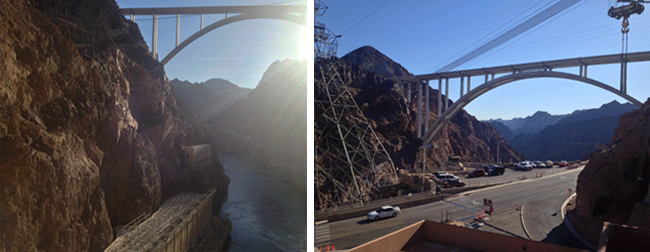 Mike O'Callaghan – Pat Tillman Memorial Bridge
Mike O'Callaghan – Pat Tillman Memorial Bridge
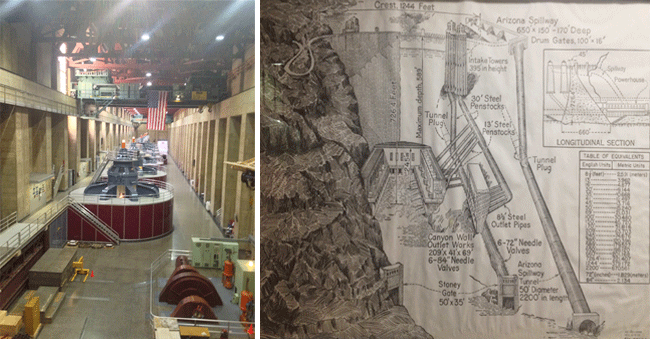 56 stories down from the visitors centre accompanied by a lovely tour guide and you'll find yourself in one of the generator rooms of the dam. The large turbines continuously take in water at speeds up to 85 mph and convert it into hydro electric power which serves over 1.3 million people per year. The smaller turbine in the photo generates enough power to serve the needs of all the dam facilities.
As depicted in the drawing above at it's thickest point the dam is made of 660 ft of solid concrete. That would be equal in distance to filling the entire generator room (shown above) with concrete and then extending that an additional 10 more feet! At the top of the dam the concrete tapers to 45 ft in thickness making the structure act like a giant wedge in the Colorado River.
56 stories down from the visitors centre accompanied by a lovely tour guide and you'll find yourself in one of the generator rooms of the dam. The large turbines continuously take in water at speeds up to 85 mph and convert it into hydro electric power which serves over 1.3 million people per year. The smaller turbine in the photo generates enough power to serve the needs of all the dam facilities.
As depicted in the drawing above at it's thickest point the dam is made of 660 ft of solid concrete. That would be equal in distance to filling the entire generator room (shown above) with concrete and then extending that an additional 10 more feet! At the top of the dam the concrete tapers to 45 ft in thickness making the structure act like a giant wedge in the Colorado River.
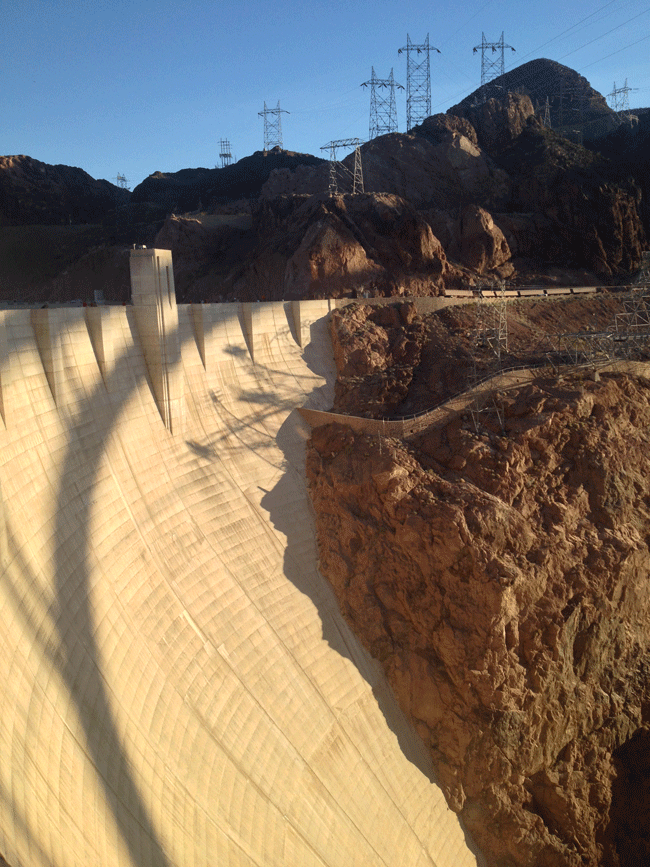 Located in an area where seismic activity is common, the concrete was poured to notch into the rock of the canyon rather than attach to it and allow for slight movements during earthquakes. The dam was built to withstand an earthquake registering an 8.5 on the richter scale. The largest earthquake to date recorded in this area registered a 5.5 and occurred in the 1950's.
Located in an area where seismic activity is common, the concrete was poured to notch into the rock of the canyon rather than attach to it and allow for slight movements during earthquakes. The dam was built to withstand an earthquake registering an 8.5 on the richter scale. The largest earthquake to date recorded in this area registered a 5.5 and occurred in the 1950's.
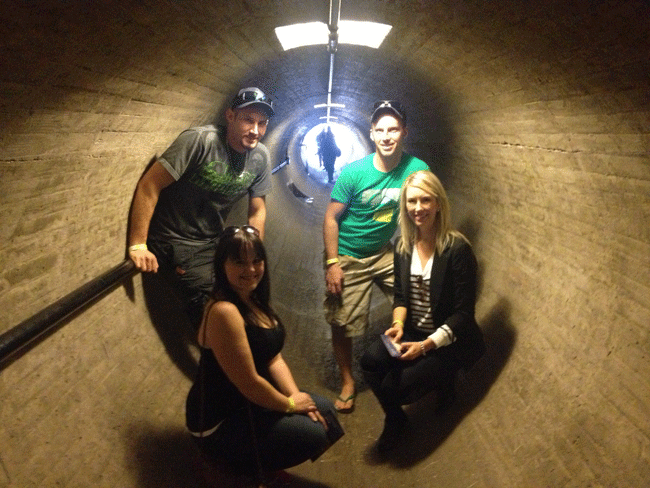 There are about 8 miles of tunnels that run throughout the structure of the dam all connected to the great outdoors (and a large drop)! I find it very inspiring that a structure this large can be passively ventilated and cooled!
There are about 8 miles of tunnels that run throughout the structure of the dam all connected to the great outdoors (and a large drop)! I find it very inspiring that a structure this large can be passively ventilated and cooled!
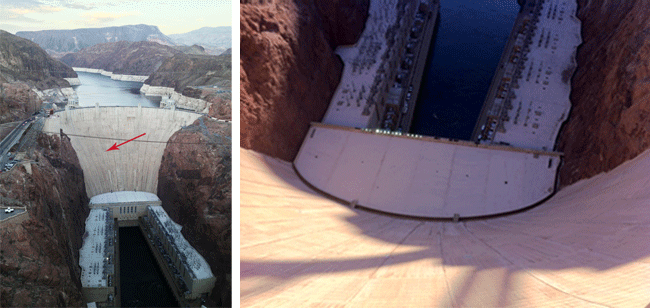 [left] The red arrow marks the location of the air vent on the dam where we stood in the tunnel above and where the photo on the [right] was taken looking down!
[left] The red arrow marks the location of the air vent on the dam where we stood in the tunnel above and where the photo on the [right] was taken looking down!
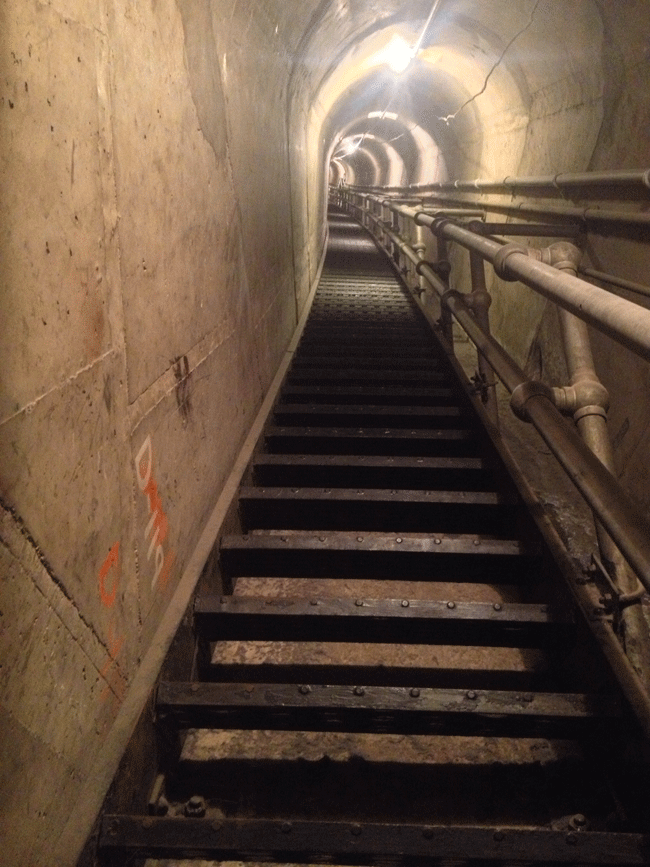 Stairway within the tunnel system of the dam
If the elevators break down have no fear! It's just 752 steps to the top of the dam. Yikes!
Stairway within the tunnel system of the dam
If the elevators break down have no fear! It's just 752 steps to the top of the dam. Yikes!
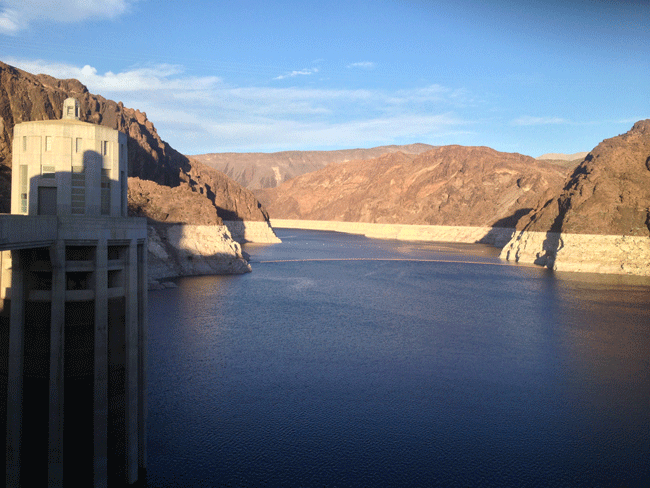 View of Lake Mead from the top of Hoover Dam
If you don't believe in global warming the effects couldn't be more obvious than on the banks of Lake Mead. Water levels have been reported at a historical low, 50 ft below average! The light colored ring of calcium and other mineral deposits on the rock in the photo above, pose as a constant reminder of the lowering water table of the Colorado River system that brings life to many regions in the western states.
For more information on the Hoover Dam visit it in person! Or you can check out the website at: http://www.usbr.gov/lc/hooverdam/
View of Lake Mead from the top of Hoover Dam
If you don't believe in global warming the effects couldn't be more obvious than on the banks of Lake Mead. Water levels have been reported at a historical low, 50 ft below average! The light colored ring of calcium and other mineral deposits on the rock in the photo above, pose as a constant reminder of the lowering water table of the Colorado River system that brings life to many regions in the western states.
For more information on the Hoover Dam visit it in person! Or you can check out the website at: http://www.usbr.gov/lc/hooverdam/
 Mike O'Callaghan – Pat Tillman Memorial Bridge
Mike O'Callaghan – Pat Tillman Memorial Bridge 56 stories down from the visitors centre accompanied by a lovely tour guide and you'll find yourself in one of the generator rooms of the dam. The large turbines continuously take in water at speeds up to 85 mph and convert it into hydro electric power which serves over 1.3 million people per year. The smaller turbine in the photo generates enough power to serve the needs of all the dam facilities.
As depicted in the drawing above at it's thickest point the dam is made of 660 ft of solid concrete. That would be equal in distance to filling the entire generator room (shown above) with concrete and then extending that an additional 10 more feet! At the top of the dam the concrete tapers to 45 ft in thickness making the structure act like a giant wedge in the Colorado River.
56 stories down from the visitors centre accompanied by a lovely tour guide and you'll find yourself in one of the generator rooms of the dam. The large turbines continuously take in water at speeds up to 85 mph and convert it into hydro electric power which serves over 1.3 million people per year. The smaller turbine in the photo generates enough power to serve the needs of all the dam facilities.
As depicted in the drawing above at it's thickest point the dam is made of 660 ft of solid concrete. That would be equal in distance to filling the entire generator room (shown above) with concrete and then extending that an additional 10 more feet! At the top of the dam the concrete tapers to 45 ft in thickness making the structure act like a giant wedge in the Colorado River.
 Located in an area where seismic activity is common, the concrete was poured to notch into the rock of the canyon rather than attach to it and allow for slight movements during earthquakes. The dam was built to withstand an earthquake registering an 8.5 on the richter scale. The largest earthquake to date recorded in this area registered a 5.5 and occurred in the 1950's.
Located in an area where seismic activity is common, the concrete was poured to notch into the rock of the canyon rather than attach to it and allow for slight movements during earthquakes. The dam was built to withstand an earthquake registering an 8.5 on the richter scale. The largest earthquake to date recorded in this area registered a 5.5 and occurred in the 1950's.
 There are about 8 miles of tunnels that run throughout the structure of the dam all connected to the great outdoors (and a large drop)! I find it very inspiring that a structure this large can be passively ventilated and cooled!
There are about 8 miles of tunnels that run throughout the structure of the dam all connected to the great outdoors (and a large drop)! I find it very inspiring that a structure this large can be passively ventilated and cooled!
 [left] The red arrow marks the location of the air vent on the dam where we stood in the tunnel above and where the photo on the [right] was taken looking down!
[left] The red arrow marks the location of the air vent on the dam where we stood in the tunnel above and where the photo on the [right] was taken looking down!
 Stairway within the tunnel system of the dam
Stairway within the tunnel system of the dam View of Lake Mead from the top of Hoover Dam
View of Lake Mead from the top of Hoover Dam